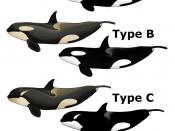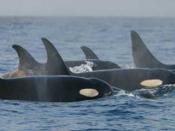The killer whales ranks as one of the most widely distributed of the more than eight species of warm-blooded and air breathing whales. Killer whales have been sighted always in large numbered packs in almost every major ocean and sea on the plant. Killer whales spend about 95 percent of their lives under water. The killer whale is a very extraordinary creature to use as humans, but when you really look at it they have many of the same similarities that we do.
Killer Whales share many similarities with humans. Like us, they are warm-blooded, they breathe air, they possess lungs, and they give birth and nurse them with rich, fat-laden milk secreted by mammary glands. In other words humans and killer whales are both mammals, members of the class Mammalia. Killer Whales are not really whales at all, but they are huge dolphins. I f someone was to trace human and dolphin pedigrees back far enough in time, they do eventually converge.
It probably occurred some 120 million years ago in the form of a common ancestor, now extinct, that bore scant resemblance to either modern humans or modern dolphin (Knudtson, pg. 22).
Reflecting this evolutionary history, modern killer whales continue to anatomically mirror those distant times. Although we think of killer whales as sleek and hairless, for example, like other cetaceans, they do posses hair, the hallmark of the class Mammalia, if fleetingly during fetal stages of development (Knudtson, pg. 23). The killer whales fetus, also transiently displays such other mammalian traits as four stubby limbs, a pelvis and a tail.
In addition, the huge skeletons of killer whale adults, so hydro dynamically sculpted for aquatic life, are, like our own, simply variations on a fundamental mammalian design (Knudtson, pg. 23). An x-ray of the killer...


